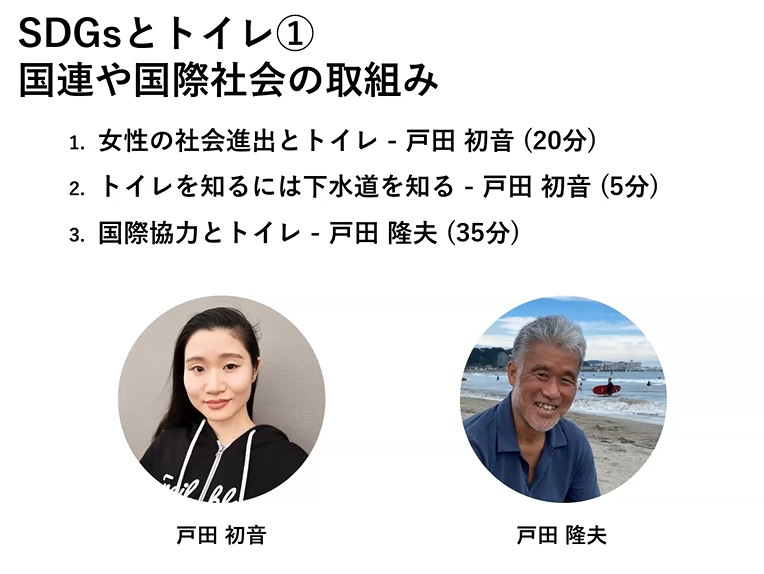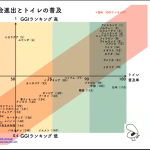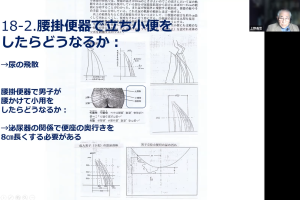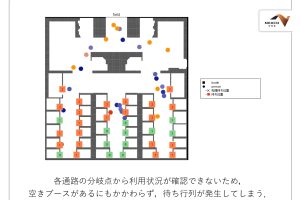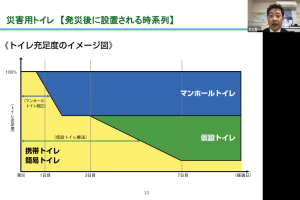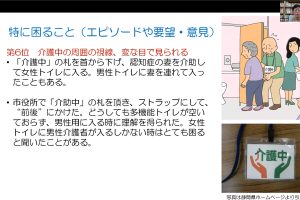The 24th seminar
“SDGs and Toilet” -1, Efforts by the United Nations and the international community
– “Evolving Toilets” book series, volume 3 “SDGs and Toilet” edited by Japan Toilet Association
Japan Toilet Association (JTA) Seminar Series; “Let us know more about our Toilet Story”
Date: 18 May 2023 (Thu) 18:00-20:00 JST
Moderator: Mikiko Takahashi, Ph.D. (JTA Director)
Presenters:
Lecturer 1; Ms. Hatsune Toda (Salesforce Japan Co., Ltd.)
(1) “Women’s social involvement and toilets Comparison with countries around the world”
(2) To know the toilet and the sewer (Toilet and sewer system in Thailand)
Lecturer 2: Mr. Takao Toda (Meiji University Special Invited Professor, former JICA Senior Advisor)
(3) International cooperation and toilets by JICA
(Takahashi (MC)) The topics of today seminar will focus on the theme of “SDG’s and toilets.”
The lecturer, Ms. Hatsune Toda, is a member of the Japan Toilet Association (JTA). She has lived in Japan, America, Bangladesh, and Hong Kong, and after graduating from university, she currently works at the marketing headquarters of Salesforce Japan. She is studying at the Kyoto University of Arts Graduate School of Communication Design since April 2023 to study more about communication methods and design concept to effectively solve the social problems.
Mr. Takao Toda is the father of Ms. Hatsune Toda. He is a former Japan International Cooperation Agency (JICA) senior advisor and is currently a special invited professor at Meiji University. While belonging at JICA, he engaged in international cooperation in various fields, including the health and hygiene education environment in the developing countries. He worked with private companies and UNICEF to solve the toilet issues. Currently, he also advises private companies on social contribution matters besides teaching at university. He established Forum 2050 in March 2023 to support children will face the world of the future.
(Ms. Hatsune Toda)
(1) Women’s social involvement and the toilets
I will talk about two items; “Women’s social involvement and the toilets” and “To know the toilet and the sewer.” The sixth goal of the SDGs is “Clean Water and Sanitation” and states the goal of ensuring that all people will be able to access to the hygienic toilets by 2030. In reality, 28% of people could access to toilets in 2000, and this has improved to 54% in 2020.
(1-1) The situation about the toilet for women in the world
I learned that there was toilet problem globally when I was 17 years old. There are approximately 8 billion population in the world, and one of three people could not use the toilet facilities properly. Approximately 892 million people defecate in the open filed on a daily basis and caused an unsanitary environment. 800 children died every day from the diarrheal diseases by the result of this unsanitary environment. I was very surprised to know that toilets problem may kill people. Some women are sexually assaulted while defecating in the open field and some girls were absent from school during the menstruation because there are no toilets in schools in some developing countries. I could not afford to accept that socially vulnerable children and women were being hurt.
(1-2) The relation between the women’s social involvement and the prevalence of toilets
I surveyed about women’s social involvement change applying the gender gap index.
The United Nations divides the prevalence of toilets into five levels from the top.
1. The safely Managed Toilet: A toilet that is not shared with other families and properly disposed of the defecation.
2. The basic toilet: A toilet that is not shared with other families.
3. The limited improved toilet: A toilet that is shared by multiple families.
4. The unimproved toilet: Without a toilet and excreting into a hole, bucket, etc.
5. The open Defecation.
I recognized that the top two toilet levels above as an indicator of the toilet environment are penetrated. There are some places around the world where people defecate in the open in the field, such as in South Saharan Africa, South Asia, India, and Bangladesh.
(1-3) Women and toilets: a situation in Japan
The first toilet improvement boom occurred in 1964 at the Tokyo Olympics in Japan. The Equal Employment Opportunity Law was enacted in 1986, and women became to get involved in the working society, then the solely women’s toilets increased gradually. The toilets have been improved along with the social changes such as the Act on Promotion of Women’s Participation and Advancement in the Workplace in 2015, Tokyo Olympics and Paralympics in 2020. We supposed that toilets have improved in Japan due to various social movements and measured to promote women’s social involvement.
UNICEF has released data about the five levels above of toilet penetration of the all countries. Each country is plotted with GGI (Gender Gap Index) ranking on the vertical axis and toilet penetration rate on the horizontal axis. The countries where men and women are unequal and where toilets cannot be widely available are plotted at the bottom left corner. The countries where the gender equality has been achieved and toilets are commonly used are plotted in the upper right corner. It can be concluded that there is a tight correlation between women’s social involvement and the toilet penetration rate. The GGI index relates to four fields: economy, education, health, and politics. It was found that there is a tight correlation between the GGI and education in these four fields.
There is a tight correlation between GGI and education consequently. This means that the penetration of the toilets is related to the field education, such as eliminating the educational gap between men and women. I conclude that women can participate well into the society when the toilets are improved. The initial hypothesis was that social movements such as the involvement of women into the workplace were boosting the penetration of toilets. However, I am still puzzling that the penetration of toilets simply pushes women’s involvement in society? I will continue survey whether there is an actual cause-and-effect relationship by the fieldwork in each country, although there seems to be a correlation. The provision of toilets will consequently contribute to the involvement of women in society and to the goals of society’s SDGs.
(Ms. Hatsune Toda)
(2) To know about the toilets which is the key to know the sewerage referring to toilets and sewerage situation in Thailand
I interned at the JICA Thailand office in 2018. Thailand holds a quite high toilet penetration rate, and 95% of locations had access to sanitary toilets in 2015. Specifically, 88% of them are the septic tanks which are not connected to the sewage. The defecate becomes unsanitary and may lead to the diarrheal diseases when it is not properly disposed. The situation with toilets in Thailand is completely different between in the homes and the commercial buildings. The commercial building toilets must either connect to the sewer system or have a septic tank installed by the law. On the other hand, many Thai homes dispose the defecate into the septic tanks. In Japan, after the defecate enters the septic tank, solid objects and the toilet papers accumulate at the bottom of the anaerobic filter tank and turn into sludge. Then it is decomposed by microorganisms, and finally disinfected by the chlorine in Japan.
On the other hand, the processed liquid is poured into rivers or permeated into the soil without being sterilized because the septic tanks in Thailand is a simple structure. There are no regulations in Thailand regarding the maintenance of the septic tanks, and the price is cheap. The microorganisms must be active because of the hotter temperature. The septic tanks are not required to be earthquake resistant because there are few earthquakes in Thailand. They are not properly managed or operated and sewage is not properly processed, although the penetration rate of toilets is high in Thailand. I doubt that there are some parts of the septic tanks that are not functioning properly. JICA Thailand office members will propose to create a legal system for the functions and maintenance of the septic tanks at the national level, communicate this matter to the people and raising awareness, and expand the market for the new septic tanks. These benefits shall be provided to the private sector.
Whereas Thai government officials said that the urgent issue is garbage matter, and that toilet issue is still lower priority. WaterAid has recently made political recommendations regarding the importance of toilets, and we wish this will be promptly promoted.
(Mr. Takao Toda)
(3) International cooperation and toilets by JICA
I worked for JICA for a long time. Currently I teach at a university and advise the private companies on their social contribution activities. I was allocated to the water resources team when I graduated from university and joined JICA. This team surveyed to develop the ground and surface water. At that time, the opinion in JICA was that people would not die even if there is not a toilet. There were little activities in toilet penetration in the 1980s.
However, the urbanization is rapidly penetrating in various areas of the developing countries as they begin to develop. They are also aware that they must ensure that the core of their sewage treatment plants. This concept was also established in the United Nations, Japan, and Western countries. The connecting sewage from factories and offices to the core infrastructure has established by the local self-help effort in the 1990s.
(Example 1) UNICEF and Great Britain aid agency started a water and sanitation program in a small village in Nigeria. Then the problem by the dirty toilets was discussed in the village. Everyone in the village recognized that the current toilets were problem and that clean toilets were essential. Then they considered what can they do by their own? As a result, a local carpenter made a wooden toilet lid which covered the toilet hole. This simple lid drastically reduced the number of flies. The bad odor from the toilet decreased dramatically. The most of the toilets in the village improved after they experienced this simple trial.
(Example 2) UNICEF instructed how to build toilets in villages in rural Somalia where about 1,000 to 3,000 people stay in one area with a goal of eliminating open defecation. The toilet was built by the villager collaboration. New villagers are required to build one toilet in each home. Once the toilet is built, the village chief and other village leaders come to see it and check it. This is a kind of ritual for letting the new people into the village. The people felt that the toilet was a part of village culture or a custom for welcoming new villagers.
(Example 3) An example of the environmentally friendly toilet in India.
This is an example of an environmentally friendly toilet that applies the sophisticated technology to create a system of the manure sump. That existed in Japan for a long time ago to reuse as the fertilizer for the agriculture. The manufacturers wish to turn this into a business. JICA aims that environmentally friendly and hygienic toilets will become common in India through this activity. However, there were problems in the past, such as the parasites when the excrement was used as the fertilizer in Japan. These problems must be solved.
(Example 4) A Japanese manufacturer and JICA collaborated to install a bio-toilet at a university in Yaounde, the capital of Cameroon, and finally it was very well received.
It was hard for female students to return home in the middle of the class because this university is located in the suburbs. This caused problems for them when their defecation or periods. Then the bio-toilets received a favourable reputation and they decided to build it more. When such toilets were installed in universities in relatively low-income people countries, it would contribute to improve the sanitary environment and the education for the young people.
(3-1) Japan’s contribution of “The global toilet revolution” to improve the hygiene
As a global issue, about one-third of people cannot easily access to sanitary toilets, and almost 500,000 people die from avoidable diseases by the unsanitary conditions. In addition to the hygiene and health issues, the toilets are closely related to the education, gender, and human rights. The populations of South Asia and the Sub-Saharan (south of the Sahara Desert) region are assumed to increase explosively, but they are lagging far behind. The SDGs emphasize this point and aim to improve not only toilets but also all social issues.
On the other hand, toilets are highly dependent on the local culture, religion, and other diversity in each region. Therefore, just imposing ideas from other countries will not solve the problem well. It is important that the people living in the local area themselves will understand and act on their own initiative. To achieve this, it is necessary the social change with a variety of people work on it in a multilayered, multifaceted, and simultaneous manner, rather than the simple orders from the government. The toilets in Japan were one of the best in the world even before economically advanced. Japan has an experience that toilets are not a result of development but a prerequisite for development. It can be said that there are few countries in the world that have had such an experience. There are more to do with the health and hygiene issues, rather than just advocating that toilets are clean and comfortable. The health-for-all agenda, universal health coverage cannot succeed without solving the toilet issues.
Japan has a variety of solutions ranging from urban toilets, office toilets, urban home toilets to rural ones. The urban areas are equipped with quite efficient sewer systems. Japanese septic tanks are called to keep the highest standard globally. It was also one of the few countries in the Edo period of 17th to 19th century that had an environmental recycling system in the urban areas. The hygiene education in Japan was extremely comprehensive in the primary education from the early Meiji period of 19th century. In particular, the early days of Japan’s health and hygiene policy was established, when many hospitals were built, drains were swept, and the communal toilets in tenement houses were thoroughly cleaned. This kind of the hygiene education was thoroughly practiced. Therefore, Japan will be able to provide various advices to other countries based on the experience with its cultivated over the long history.
(3-2) Examples of JICA’s multi-sector initiatives
The support for toilets has basically been provided in connection with the water supply, water-related support, or health and hygiene support. In fact, Japan is the top in the world in terms of cooperation in the water sector both in the numbers and budget costs. It is almost the same level with the World Bank, or even more than it. JICA members will take the lead in providing the grant aid, the technical cooperation projects, and large-scale fund loans.
We particularly emphasized on addressing hygiene and toilet issues in the primary education. The safer toilets for girls were also built from the late 1990’s when the elementary schools were built. The administration, schools, and communities cooperated to discuss on the various matters in the field of the education. The idea about how toilets shall be designed for the children must always come up in the agenda. We cooperated in constructing about toilets matching to the area by reflecting this agenda.
In addition, people from all over the world who are related to a particular theme gather in a specific place, such as Japan, to engage in knowledge co-creation about topic-specific training. For instance, the issue of toilets always comes up when the theme of the school health is discussed. Currently, we are working together to create toilets that can be operated and managed by the residents, while improving the sanitary environment in extremely unsanitary slums and impoverished areas. Even if the project is completed, it will quickly collapse if only forced from outside. Therefore, it is quite important to let the local people understand the reason of the necessity of the toilet by means of the educational activities. Toilet issues are always included when the slum redevelopment or health infrastructure improvements.
A huge budget was spent to develop a large-scale sewerage infrastructure in India in the 1980s, when I was a member of the water resources team. At that time, we built 1,000 public toilets in the area. In terms of maintenance, we worked with local NGOs in India to keep sustainability by the paid toilets in some areas. The sewerage projects are relatively unremarkable among the international projects. Then, toilets are often built to highlight Japan’s cooperation in improving the sanitary environment in the region.
(3-3) The collaborate efforts with the private sector and supports to the small and medium-sized companies
There are many small or medium size companies in Japan holding global class advanced technology. They are trying to develop the septic tanks and sewage systems. JICA proceeds many projects to demonstrate commercialization and to disseminate and expand the technology. We wish this kind of activity will lead Japan’s international contribution from now on.
(3-4) The situation of toilets in the world
The regions of the people with less access to basic sanitation toilets are South Asia, India, sub-Saharan Africa, and Papua New Guinea. There are still many countries where less than 30% of toilets have sanitary facilities. It is important to provide support for toilets to these countries where the health and hygiene indicators are quite low. The ecosan toilet are designed to separate stool and urine or both can be used. In some areas where users are limited and highly aware of using toilets, they are useful as they use it properly. On the other hand, there were some areas where it was not being used properly in poor condition.
The effectiveness of toilets depends on the users’ behaviour and how to be used. Normally once a model project is successful, the next step is to disseminate it in the international cooperation. However, it is not easy to apply this way to the toilet. Referring to the mortality rate for children under the age of 5, there are many regions with difficult access to toilets, such as South Asia, sub-Saharan Desert, Thailand, Papua New Guinea, and Indonesia. These countries have very large populations and are faced with many health and sanitation problems and toilet problems. JICA takes into consideration the circumstances of the Japanese company, depending on the situation, regarding the evaluation of ideas, how to develop those ideas, and supporting for the activities for the developing countries, when expanding overseas as a private business. We must adjust the way when we will provide the support.
(3-5) The security for the mankind; Current international cooperation with the toilets
Toilets are not luxury goods but essential to protect human life and dignity, and keep the global environment. The importance of toilets must increase in the future, both in Japan and the world. “The security for the mankind” is an important word. Japan values this philosophy.
The security for the mankind consists of three principles defined by United Nations resolutions: “Avoidance of fear”, “Elimination of poverty” and “Freedom to live with dignity.” Ms. Sadako Ogata jointly declared the Security for the Mankind Committee with Nobel Prize winner Ms. Amartya Sen. The committee report provides the following definitions; Keep “Protect life,” “Livelihood,” and “Dignity” for the all human. Then, both “Protection” and “Capability enforcement” are essential to achieve these principles.
The term “The security for the mankind” includes two meanings.
The first point is to emphasize “Life”, “Livelihood” and “Dignity” as the core of the basic matters necessary for the people to live a full life to be happy. This philosophy includes a strong will to focus on these cores as our abilities are sometimes limited.
The second point is “Protection” and “Empowerment.” People in any situation will keep dignity and potential. The emphasized point is that these people demonstrate their latent abilities and solve themselves or each other in solidarity.
(3-6) Challenging the “World Toilet Revolution”; Future international cooperation and toilets
[1] We do not know the solution where is the truly ideal toilet or toilet centred system. Even if we may know, there probably are multiple solutions. But what we recognize is that we can find values on the toilet to make us happy. In fact, what extent should we use the limited resources such as the water to create that value? Currently, we still cannot find a new ideal goal for toilets, and only we can do it through trial and error. However, there is a large opportunity for the value creation. It is true that the difficulty finding the solution for the idea of “No One Left Behind” in the SDGs which is often said to be doubtful and we admit it eventually.
2] Many people are becoming aware of the value of toilets, including the leaders in large countries such as China, Philippine, and India. The clean toilets are not only a matter of sanitary environment, but also the image of the nation and the business. They are quite essential, especially in countries that attract people such as the tourists. This is a huge tailwind for those who wish to drive a toilet revolution, and we can take advantages of it wisely. The reason why Japan was able to support the construction of 1,400 public toilets in India was because it was able to tune in the political trends in India.
[3] Many resources including water are finite. Whereas, there is also infinite resources of power to generate various wisdom, come up with ideas, share them, and work together. What is important is how to utilize those resources globally. It must be reminded that one success toilet in an area cannot always apply elsewhere. We need the wisdom not to limit one success to just a small isolated case. How can we develop what we learnt from a trial and possibly deploy it globally? Therein lies the solution to the toilet problem. I hope that if we successfully solve the problem, we can probably apply it to other similar ones as well.【Q&A】
(Q1: HO) The correlation coefficient showed that there is a positive correlation of 0.7 on the education and toilets, but what about the relationship with women’s social involvement?
(A1-1: Hatsune Toda) Regarding women’s social involvement, I used the numbers measured by GGI’s with overall GGI index. There is a figure of 0.29 regarding the penetration rate of toilets. Therefore in the general review of GGI, I think there is a weak positive correlation between women’s social involvement and the prevalence of toilets.
(A1-2: Takao Toda) The enrollment rate of female elementary school students in Niger is extremely low. The problem about the provision of toilets for the girl pupils was pointed out by Niger’s approximately 9,000 school education boards. JICA has been cooperating with Niger for nearly 20 years, and during that time the enrollment rate of girls has increased considerably. Niger is said to be one of the poorest countries in the world. The idea was to provide women with the education so that they can advance in to the society and to build women’s toilet for this purpose, and this practice was carried out nationwide with Japanese providing supports.
(Q2: M. Takahashi) I think it is not only necessary to educate those who use them, but also those who make them and the government to popularize toilets. To whom what kind of education did you provide?
(A2: Takao Toda) I proposed about the necessity to do things multi-layered, multifaceted, simultaneously, and sustainably in my lecture. The basic starting point is all stakeholders will commonly understand the value of toilets. However, the poor village’s leader may say there are many other things to do before a toilet. He/She thinks it is anyway important for the parents to let their children help with the farm work and household chores. Under such circumstances, I think the starting point is that everyone will come to a common understanding of the various valuable values through discussion that toilets hold and the value to protect the core of human existence.
(Q3: HO) Japan Toilet Association conducted a study on Prime Minister Modi’s toilet reforms in Indian schools from around 2018. What is the current situation there?
(A3: Takao Toda) Japan is providing quite large-scale toilet support to India, not only in schools but also in public toilets. However, there are many regional differences as it is a large area country. For instance, Varanasi region where is near Prime Minister Modi’s hometown, the schools and public toilets are well maintained under the leadership of the mayor. On the other hand, there are relatively little awareness in environmental issues with the toilets in the southern regions where are many opponents of Prime Minister Modi. My experience in the field is that the level of awareness in each region will greatly impact.
(Q4: HO) How should we incorporate it into each country’s context in order to realize the ideal toilet that includes human security related to life, livelihood, and dignity?
(A4: Takao Toda) We can’t afford to find the solution in the fine office where is far from the real field. The important point is to survey the exact situations with the local context. On the other hand, there is unique role by the foreigners. Local people know the area well. However, they hardly know about the toilet situations in other distant countries and then the foreigners’ role is to introduce them about the other situation. Our goal is global social change and we can introduce and share our experiences with many failures and successes, tailored to local people, based on various examples. I think this is a very important role for us as foreigners stand point.
(Q5: HO) There is a real war going on right now, and as a result, energy shortages are becoming serious. The energy is essential for facilities to operate current toilets with the water and sewage systems. These issues of energy distribution should come first rather than SDGs which pursue sustainability advocated by the United Nations from the perspective of human security, along with life, livelihood, and dignity.
(A5: Takao Toda) The energy issues are also part of the SDGs to cover major development issues. However, the priorities and synergies of the 17 goals and 169 targets of the SDGs depend on each country’s situation. Actually, this is a serious issue, particularly in the post-SDGs era. I think we need to have a thorough discussion about how to prioritize and allocate resources among these many important issues.
I published a book titled “Development and post-SDGs” (Soseisha Shinsho 66) in preparation for the post-SDGs. Please read it.
(Q6: KA) The flush type toilets are quite common in developed countries. It must be necessary to create toilets that do not use water from a global and long-term perspective?
(A6-1: Hatsune Toda) I think that using water is not global standard but we take it for granted. I don’t think that setting a sewage system, flushing, and thorough decomposition is necessarily as an appropriate method for all countries.
(A6-2: Takao Toda) Perhaps the water saving toilet models will become the global standard. There are two occasions when water is used at the modern toilet to dispose of excrement and to clean the buttocks. Nowadays people are already aware of the comfort of cleaning the buttocks. I think it must be difficult for us to give this up.
The waterless toilets for the excrement disposal may also be available in some regions in the future. We expect major Japanese manufacturers such as TOTO and LIXIL will develop a model that overcomes constraints such as the water resources and electricity and become popular globally to be the world’s highest standards. I think it would be a great contribution to the world.
(Q7: Takahashi) Are there any countries besides Japan that cooperate in building toilets in developing countries?
(A7: Takao Toda) One of the most important actors for the toilets is UNICEF. Most of the support is provided in educational field, but they also provide multifaceted support from the perspective of protecting children and people.
Once Europe and United States used to be active, but their vitality in the field has gradually been lost, and toilets in public facilities, especially schools, hospitals, and community spaces, are being slow. I think Japan’s international cooperation in toilets through JICA is at the forefront. Considering the depth and diversity of Japanese companies, from large corporations to venture companies, and the dynamism of technology ranging from the toilet facilities to the septic tanks and sewage, Japan is the main actor in the toilet revolution and will continue. European and American countries withdrew from project-based activities from the 1980s to the 2000s. However, Japan did not withdraw. Even when these countries changed their policies and returned to Japan’s methods, much of the ingenuity on the ground was lost including toilet cooperation. However, there are some NGOs that are trying their best to help local communities within their own constraints, and Europe and UNICEF are also doing their best.
(Q8: Kawauchi) When we try to realize the comfortable toilets by our envision today, much more water and energy are necessary. This will pose a problem in terms of sustainability. On the other hand, Ms. Hatsune Toda mentioned that the United Nations divides the toilets into five levels. Among them, the most highly rated toilet systems are ones that flush with water, have a sewage system, or require the water or energy. Considering this matter, it will be necessary to change the five levels themselves?
(A8-1: Hatsune Toda) I think the best toilet is the excrement is properly disposed. In the current situation, the system uses water, but I think there will be developed other ways to treat it.
(A8-2: Takao Toda) Both rich and poor countries must be aware the resilience of not being connected to the sewage systems. If the water supply and sewage services stop, all of Japan’s current toilets will become unusable. I think toilets usable without being connected the water and sewage systems can be used even during the disasters or wars. I think it is necessary to classify them in terms of their resilience.
(C9: Kawauchi) There were some places at the Catastrophic East Japan Earthquake in 2011 where the ground liquefaction occurred and all the sewage water stopped, and all the toilets were completely unusable. Is it really the right way to dispose of the feces by connecting it to a sewer pipe and collecting it in one place? I think it’s natural to think that this is not just a water resource issue, but also that the vulnerability of the total toilet system.
